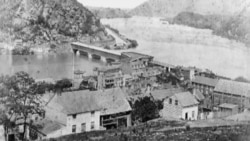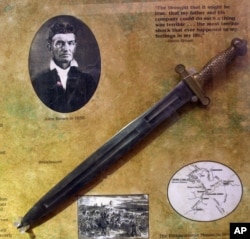Slavery and the Civil War were some of the darkest chapters in American history. But one man predicted the bloody conflict and believed armed insurrection was the only way to overthrow the institution of slavery in the United States.
John Brown's prophecy came true, but now, 158 years after his death, people are still in turmoil over the legacy of the controversial white American abolitionist.
"Some believe he is a tyrant, and even use the word terrorist. Conversely, others say no, he is a freedom fighter, he is a martyr, he is a hero."
Those are just a few of the sentiments Dennis Frye has heard over many years. Frye is chief historian of the Harpers Ferry National Historical Park. He grew up in the shadow of the national park made famous as the site where John Brown attempted to launch an uprising and slave rebellion.
‘Frustrated American’
"John Brown is a very frustrated American. He was so angry that he determined the only way to remove slavery from the country was through violent overthrow of the institution, to literally eliminate it through war," Frye said.
Brown led a group that took control of the U.S. Army's arsenal in Harpers Ferry in 1859. Brown and his men planned to steal 100,000 rifles from the Federal Armory and distribute them to thousands of black slaves and white abolitionist fighters in an effort to overthrow the government.
John Brown wanted his army to orchestrate a huge migration of slaves from southern plantations.
"The rest of the plan is provide them with armed protection as they migrate North to the promised land, to the land of freedom, to the ground north of the Mason-Dixon line, where they would be free, Frye said.
"But Brown's plan went terribly wrong. Thirty six hours after he captured the armory Brown was surrounded by Marines at the armory's fire engine house. Soon after that he was captured alive."
Frye said Brown was dragged out of the engine house, taken to nearby Charles Town and placed on trial for murder and treason. “Only six weeks after his capture, Brown was executed, on December 2, 1859.”
Life before the raid
Before the Harpers Ferry raid John Brown was a wanted man. He grew up in an abolitionist in a deeply religious family.
“His family, his parents brought him up that everyone should be treated equally, and there should be no concern with sex, gender, race, anything, it is just everyone should be treated equally,” said Alice Keesey Mecoy, great-great-great granddaughter of John Brown.
From her home in Texas, Mecoy told VOA Brown’s passion was in abolitionism, but he had to provide for his second wife, Mary Ann, and 10 children. After living in several states, he and his family would establish a family farm in North Elba, New York, an area in which black families resided.
Historian Frye explains religion fueled the family’s activities in the furthering of the abolitionist movement.
“The absolute eradication of the stain of slavery, every family member believed in, there were no rebels in John Brown’s family, except rebels against slavery.” Frye said.
Brown’s belief that God had a mission for him to end slavery led him and five of his sons to Kansas in 1855, where a battle was occurring to decide if the state was to become free territory or slave territory. The Brown's took on the pro-slavery forces as well as government forces. John Brown became a wanted man.
“He gained a reputation as an outstanding guerilla fighter, but everything he was doing was illegal and he had a price on his head,” Frye said.
Family after execution
Only one son, Owen, out of the three who participated in the Harpers Ferry raid would escape, he would be racked with guilt for his survival.
The limelight was ever-present on the family in New York following John Brown's execution. This led his wife Mary Ann to move the family across the country, 3,000 miles, to the state of California, where Mecoy grew up. Mecoy said Mary Ann looked to start a new life for her children, where they were not quite as notorious.
It was not until 1976, when as a teenager, Mecoy and other family members would learn of their relation to John Brown.
Former slave and renowned abolitionist Frederick Douglass was a friend of John Brown, but did not join him on the raid. Dennis Frye said 22 years after Brown's execution Douglass believed his actions were a success.
"Douglass would firmly state that John Brown had commenced the Civil War, that Brown was responsible for starting the war that brought the ultimate end to the greatest stain in American history, the enslavement of human beings," Frye said.
Jemima Homawoo contributed to this story.










